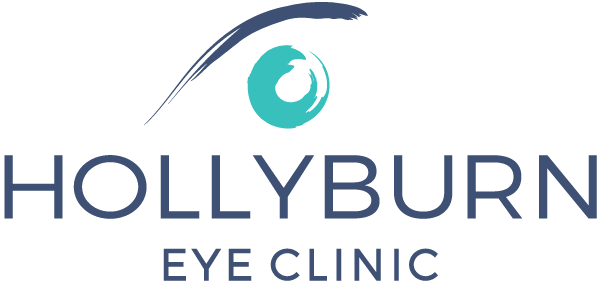Dry Eye
WHAT IS DRY EYE?
Dry Eye Disease is a common condition that occurs when your tears aren’t able to provide adequate lubrication for your eyes. Tears can be inadequate and or unstable for many reasons. This condition can affect the vision, comfort and health of the eye. Hollyburn Eye Clinic recognizes the impact dry eyes can have on everyday life and can provide customized treatment plans for all severities of dryness.
Every time you blink, a film of tears is spread across the eye keeping the surface of the eye smooth and clear. This film is formed of three layers: an oil layer, a water layer and a mucus layer; each layer having its own function in maintaining a healthy tear film.
Oil Layer: is formed by meibomian glands, located on both the upper and lower eyelids. This layer is the outermost portion of the tear film and helps keep the tear surface smooth and prevents tears from drying too quickly.
Water Layer: is formed by the lacrimal glands in the eyelids. This layer is the middle of the tear film and makes up a majority of what we see as tears. It functions to clean the eyes of any particles that do not belong in the eye.
Mucus Layer: is the innermost portion of the tear film. This layer functions to help spread the water layer and keep tears stuck to the eye.
WHAT CAUSES DRY EYE
Patients with dry eyes either do not produce enough tears, or produce tears of poor quality. Dry Eye Disease can be intermittent or chronic and can be caused by environmental or biological factors, which include:
- Age and Gender
- Certain medications including antihistamines, decongestants, blood pressure medications, and antidepressants
- Certain medical conditions including rheumatoid arthritis, diabetes, thyroid disease, Sjogren’s Syndrome and other autoimmune diseases
- Blepharitis
- Environmental conditions – exposure to smoke, wind or very dry climate
- Other factors – extensive computer use or contact lens wear and refractive eye surgeries
WHAT ARE THE SYMPTOMS OF DRY EYE?
- Dryness
- Burning or stinging
- Itching or irritation
- Redness
- Sandy/gritty feeling or foreign body sensation
- Sensitivity to light
- Watery eyes
- Stringy discharge
- Blurred or distorted vision
DIAGNOSTIC TESTING
In order to create a customized treatment plan to address your dry eyes, a series of diagnostic assessments are conducted to determine the cause of your dryness.
- Slit Lamp Exam – microscopic evaluation of the front physiological structures of your eyes, which includes your lids margins, glands, cornea and conjunctiva.
- OSDI – A 12-item questionnaire that helps assess your dry eye symptoms and subjectively grade the severity of your dry eye disease.
- Meibography – this device takes infrared images of the meibomian glands located in the upper and lower eyelids.
- Tear Osmolarity – this device is used to measure the composition of your tears.
- Tear Break Up Time – this value is used to measure the time taken for a dry spot to appear on the surface of the eye after a complete blink.
HOW IS DRY EYE TREATED?
Dry Eye treatments aim to restore and maintain the stability of your tears, in order to decrease symptoms and discomfort. Our doctors will conduct a thorough examination to determine the root cause of your dry eyes and create a customized treatment plan for maximum relief. At Home Treatments may include:
- Artificial Tears/Ointments –Artificial tears are recommended to help supplement your tear film and to keep eyes lubricated throughout the day. In some cases, ointments are recommended for nightly use.
- Prescription Medications – Anti-inflammatory or immuno-modulating eye drops, such as Restasis and Xiidra, are often prescribed to help reduce the inflammation on the surface of your eyes and eyelids.
- Lid Hygiene – Eyelid wipes and various eyelid shampoos can help reduce build up on the lid margins and oil glands. Additionally, doctors may recommend hot compress masks that open clogged oil glands and reduces dry eye symptoms
- Supplements – Adding specific omega-3 fatty acids to your diet can help with dry eyes, as they work to improve the quality of tear secretion and can further help reduce inflammation that is prominent in Dry Eye Disease.
In Office Treatments:
- Radiofrequency: We use radiofrequency waves or subdermal heat to dissolve clogged oil glands and help reduce inflammation in and around the meibomian glands. This improves long-term function and health of the glands. Radiofrequency requires a total of 4 treatment sessions; each session lasts about 20 minutes and is conducted 2-3 weeks apart. This procedure has been used in dermatology for years and also reduces the appearance of fine lines and wrinkles.
- BlephEx®: This is an office procedure that helps to clean the eyelid margins by removing excess bacteria, biofilm and bacterial toxins, which is commonly seen in dry eye and blepharitis patients. A microsponge is used to clean and exfoliate the eyelid margins for about 6-8 minutes and is supplemented with at-home lid hygiene regimens.
Did you know?
Request an Appointment
We can accommodate your busy schedule and we do direct billing!
Still have questions?
Let us know how we can help.

